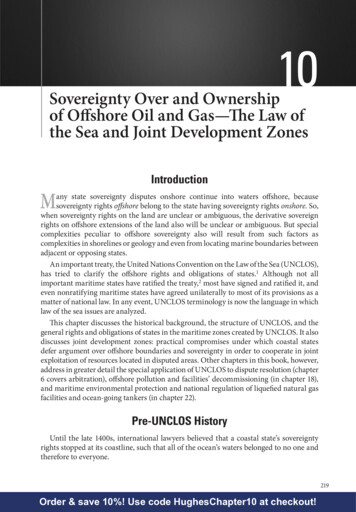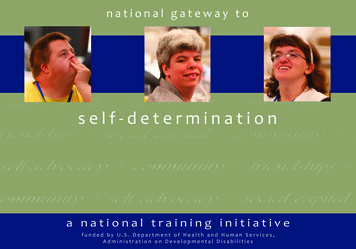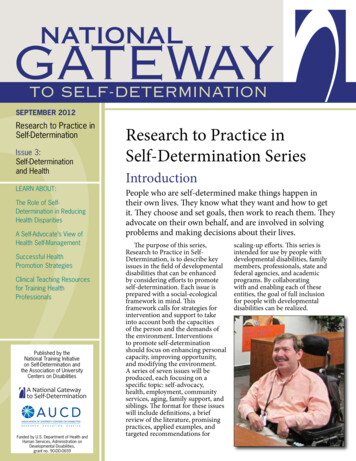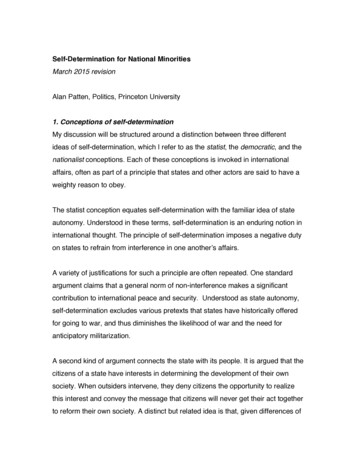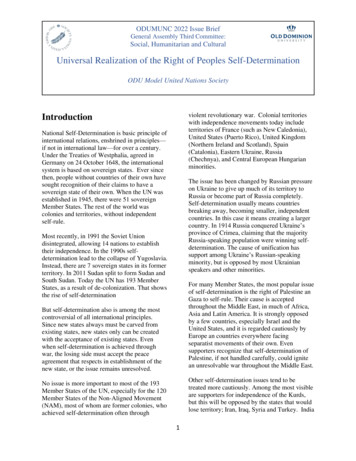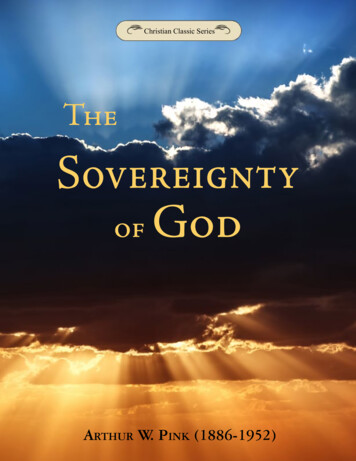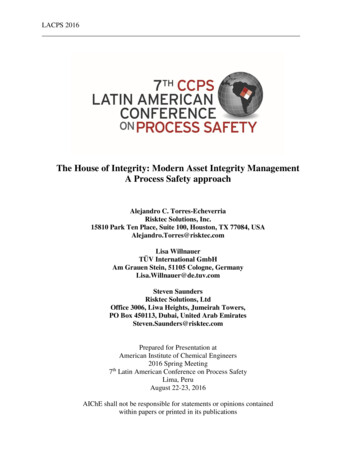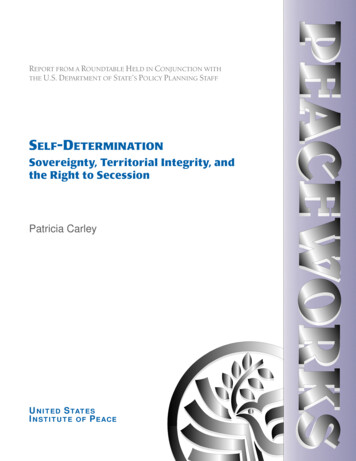
Transcription
REPORT FROM A ROUNDTABLE HELD IN CONJUNCTION WITHTHE U.S. DEPARTMENT OF STATE’S POLICY PLANNING STAFFSELF-DETERMINATIONSovereignty, Territorial Integrity, andthe Right to SecessionPatricia CarleyUNITED STATESINSTITUTE OF PEACE
CONTENTSSummaryvPrefaceix1 Introduction12 A History of the Self-Determination Concept33 The Rise of Contemporary Self-DeterminationMovements54 The Self-Determination Principle: Legal Definitionsand Obligations85 A Specific Case: The Crisis in Chechnya116 U.S. Interests and Possible Policy Options137 Conclusion18About the Author19About the Institute20
vSUMMARYThe right to self-determination has becomeone of the most complex issues for U.S. foreign policymakers and the internationalcommunity at large. Confusion over the issuestems not so much from whether there exists aright to self-determination, which is included inmany international human rights documents, butfrom the failure of those documents to define exactly who is entitled to claim this right—a group, apeople, or a nation—and what exactly the right confers. At the same time, the international system,particularly in the post–World War II era, hassteadfastly defended the inviolability of existingnation-states’ borders, regardless of how and whenthey were determined.In recent years, many groups that constitute minorities in their states have invoked the “right toself-determination” in their demands for autonomy—or, in some cases, secession—and have resorted to violence to pursue their aims. Thesegroups typically justify their demand for self-determination as a way to end years of repression andhuman rights violations by the majority ethnicgroup or the central government. The absence of aprecise definition of what the right to self-determination entails has left the international community, and the states concerned, without guidingprinciples with which to respond.Recognizing the challenge to peace posed by demands for self-determination (and governments’responses to them), the United States Institute ofPeace, working with the Policy Planning Staff ofthe U.S. Department of State, assembled a group ofpolicymakers and scholars to examine the origins,growth, and strategies of such movements, and todiscuss whether universal principles can be developed to inform international, and particularly U.S.,responses. This report summarizes the discussionsat that meeting.Self-determination as a political force in international society is a relatively recent phenomenon,emerging in the aftermath of World War I and thebreakup of the Ottoman and Austro-Hungarianempires as a demand of national groups seeking todivide territory. President Woodrow Wilson wasthe statesman most closely identified with the selfdetermination principle, though ironically theterm does not appear in his “Fourteen Points”speech. While he referred to minority rights withina larger state, he rarely mentioned the establishment of new, independent states.Self-determination became officially sanctionedafter 1945, when it was included in the United Nations Charter, though it applied to existing states,not to peoples or national groups. However, selfdetermination quickly evolved from a principle toa right, especially after the 1960 UN Declarationon the Granting of Independence to Colonial Peoples, when the term came to denote decolonization. Still, self-determination applied to territoriesand not to peoples.Since the 1970s, there has been a move to combine the ideas of minority rights and decolonization, and the result has been a tendency on thepart of some advocates to define self-determination as conferring the right to independent statehood on every distinctive ethnic group.Many observers of this trend share the concernthat confusion about what the principle of selfdetermination means and what putative rights itconfers is helping to fuel the violence characterizing contemporary independence movements. Yetthe realities of the international system provide arationale of sorts for such movements, includingthe view that internationally recognized bordersare “artificial, arbitrary, and accidental” and thatthey in fact legitimize the combining of differentpeoples arbitrarily, and often against their will,
viwithin the same territory. Moreover, the growth ofthese movements is not a temporary phenomenon, but the direct result of changes in the worldwrought by the universal application of Westernideas such as democracy and human rights. Mostof the world’s peoples have little experience withthe West’s long history of sovereignty and statehood and are thus not prepared to adhere to theWestern insistence on the inviolability of existingborders. Those in the West who are alarmed by thegrowth of these nationalist movements shouldconsider not whether these contemporary manifestations of nationalism are legal or appropriate,but rather that they are happening—and that theyvery likely cannot be stopped. The potential for violence and international instability becomes evenmore obvious when one considers that some stillvery large empires, such as Russia and China, arelikely to be affected by these movements.Unfortunately, turning to international legalstandards on the right to self-determination doesnot resolve the problem, since the right has neverbeen explicitly defined. In any case, it is impractical to assume that legal principles alone will resolve what are essentially territorial and politicaldisputes. Because the right has never been defined,the notion of self-determination typically embracesseveral different meanings, none of which addresses the central issue of how to respond to a national or other identity group’s aspirations for control over the lives of its members.Without a doubt, any new definition of selfdetermination must include customary humanrights standards (e.g., respect for individual andminority rights) and the right of an appropriatebody to enforce those standards. In their laterstages, self-determination movements typically become the target of human rights violations, whichshould be addressed before they reach the often intractable phase of organized struggle against thestate. However, the right to self-determinationmust be separated from the right to secession andthe establishment of independent statehood, withthe understanding that there are intermediate categories short of statehood that can address a minority group’s interests and aspirations, such as membership in various international forums or regionalorganizations. Human rights violations are easy tocondemn; the dilemma is whether they justify thepersecuted group’s secession from the state, aconclusion the international community is largelyunwilling to draw. Thus the question becomes,Can a principle be developed that stands somewhere in between recognized human rights standards and the right to self-determination?Somewhat ironically, the very propagation ofthe idea of human rights intensifies demands forgreater recognition among minority groups that invoke claims of human rights violations to supporttheir demands. However, the idea that humanrights and political stability are bound to clash istenuous, since states held together through terrorand repression are rarely stable in most senses ofthe word. In the end, though, it may not be possible to compel an oppressive government to end itsunacceptable actions toward a minority group ifoutside countries are unwilling to intervene withmilitary force.U.S. policy interests in the self-determinationdebate beg a preliminary question: What exactlydoes the United States care about with regard toself-determination movements—the outcome ofthe struggle (i.e., the shifting of boundaries and theproliferation of states) or the means used to obtainit (i.e., the violence that frequently accompaniessuch struggles)? Unfortunately, American diplomacy often cannot decide between these two interests, making a response that much more difficultto formulate. Generally, though, the United Statesshould be less concerned about outcomes in thesestruggles than about the means used; internationalpolitical stability is more likely to be maintained byfocusing on the process than by trying to manipulate events to arrange a predetermined outcome.The options for a minority group waging astruggle for self-determination do not have to beviewed in the zero-sum terms of independence orassimilation, despite the fact that international lawtends to reinforce this approach. The United Statescould encourage the practice of granting some intermediate status short of independent statehoodto unrecognized peoples or other distinct economic or political entities. Parallel or multiple representation for substate entities that function autonomously (such as Taiwan’s participation in theGeneral Agreement on Tariffs and Trade) can provide outlets for what otherwise might be secessionist pressures. Legitimate secessionist aspirationscould be diverted to nonterritorial demands, thusavoiding a strictly territorial interpretation of
viiself-determination. The United States might alsoconsider advocating a change in the current system that allows the government to conduct its affairs only with other states and not with subunitswithin states. However, offering subgroups somesort of recognition or representation in international forums or organizations may ultimately leadto greater demands from smaller and smaller identity groups for independence and UN representation.The United States may have no choice but toavoid the pronouncement of clear doctrines andprinciples regarding self-determination movements and thereby avoid being driven to intervenein conflicts according to rigid principles that certainly do not apply in every instance. The UnitedStates should, however, make absolutely clear thatsecession has not been universally recognized asan international right. It may choose, on the basisof other interests, to support the secessionistclaims of a self-determination movement, but notbecause the group is exercising its right to secession, since no such right exists in international law.At the same time, an absolute rejection of secessionin every case is unsound, because the UnitedStates should not be willing to tolerate anotherstate’s repression or genocide in the name of territorial integrity. Secession can be a legitimate aim ofsome self-determination movements, particularlyin response to gross and systematic violations ofhuman rights and when the entity is potentiallypolitically and economically viable.Unfortunately, there is no easy solution to thedilemmas presented by self-determination movements in the world today. Clearly, in the face of thegrowing number of such movements, establishinga definition of the right to self-determination isnecessary, though agreement on such a definitionwill not be easy—and even then, it will not likely beconclusive and unequivocal. The desire among national groups to seek self-determination is not asimple matter with a single cause. Rather, it stemsfrom multiple sources, including the denial of minority rights, territorial disputes, national aspirations, and the belief in economic and political viability, among others. This desire may developgradually until the last resort to violence and secession come into play. Unfortunately, the inattentiveness of the world community often makes what isin fact a gradual process seem very sudden.
ixPREFACEThe thorny topic of self-determination has increasingly demanded the attention of U.S.policymakers and the international community. Partly because of the postwar communications revolution, peoples around the globe have anincreased awareness of the state system’s seemingly permanent configuration and of their placein it. Some of these groups, whether in pursuit ofgreater international recognition or in response torepressive government policies, are now seeking toexercise what they see as their right to self-determination, which they assume includes the right to independent statehood. Do such groups have thisright? Is this an inevitable consequence of theprocesses of imperial dissolution, decolonization,and increased global awareness? How should theinternational community, and the United States inparticular, respond?All too frequently, self-determination movements resort to violence to achieve their aims. Theorigins of these movements sometimes remain obscure, however, and the outside world pays littleattention to them until conflict breaks out, leavingsimilarly inclined groups with the “lesson” that violence is the only practical course of action. And, ofcourse, it is that much more difficult to determinea policy response when conflict has raised both thestakes and the resolve of the players to pursuetheir aims at all costs.With its mandate to pursue the study of peaceful resolution to international conflicts, the UnitedStates Institute of Peace convened a meeting on“Self-Determination: Sovereignty, Territorial Integrity, and the Right to Secession” in February1995. The all-day session, organized in conjunction with the Policy Planning Staff at the U.S. Department of State, allowed government policymakers and outside experts to gather and discussfreely, practically, and informally the complex issues surrounding self-determination and secessionist movements. The informal nature of the discussions is particularly important, because in theWest the issue of self-determination is often addressed from a formal, legalistic standpoint. Whilemost of the participants in this session were wellacquainted with the political and legal terminologyused to describe self-determination, what it meansin practical terms is by far the trickier issue. Because self-determination encompasses so many issues—including individual and minority rights, regional autonomy, government repression,territorial integrity, state sovereignty, and claims toindependence, to name but a few—the most difficult task in planning such a meeting was to determine which aspects of the issue would be addressed. The resulting focus on territorial integrityand the right to secession should not suggest thatthe other aspects are not important; rather, it wasan attempt to set limits on a topic that can easilybecome extremely complicated and broad.The discussion proved to be so valuable that theInstitute decided to make it available to a wider audience. The session’s report, we believe, fills a gapin the literature available to members of the U.S.policy community who do not always have the opportunity to read longer, more in-depth, scholarlytreatments of the subject. While the United StatesInstitute of Peace has published many works examining the causes behind various self-determination movements—books such as Minorities at Risk:A Global View of Ethnopolitical Conflicts by TedRobert Gurr and its Series on Religion, Nationalism, and Intolerance—this is the Institute’s first effort to address the theoretical and practical aspectsof the self-determination problem in such a comprehensive manner. The Institute plans to hold
xfollow-up meetings to explore the self-determination issue further, and reports from those sessionswill also be made available.The meeting was organized by Institute program officer Patricia Carley. The Institute wouldlike to thank Adam Wasserman of the Departmentof State’s Policy Planning Staff for helping to organize the meeting. This report was prepared by Ms.Carley and edited by Peter Pavilionis.
11INTRODUCTIONThe right to self-determination as declared inmany international documents is fast becoming one of the thorniest issues for the international community and U.S. foreign policymakers in particular. Considerable confusion andconflict have resulted not so much over the notionof the right to self-determination, proclaimed insuch documents as the International Covenantson Human Rights and the Helsinki Final Act, butover the definition of self-determination. What exactly does this right entail—autonomy? statehood?What other rights come with it? Who is able to exercise it? Who is not, and why?Since the end of World War I, and especiallysince World War II, the world has ordered its affairs with an international system based on theconcept of states whose borders, no matter howthey were originally determined, are considered inviolable. However, few, if any, nation-states have international borders that unambiguously encompass one nation or people, or even several peopleswho voluntarily agreed to become part of onestate. Many peoples, distinct and recognizable bymost criteria, do not have their own nation-states,and they find themselves a discrete minoritywithin a state. In some cases, they are dividedamong several states.The United Nations, and other international organizations have steadfastly defended this systemof states. They have also defended the right of peoples to self-determination as outlined in the UNCharter. However, the self-determination principlehas been interpreted differently at different timesand has been inconsistently applied as a result. Inthe wake of rapid political, social, and technological changes in the world, distinct national groupshave pushed demands for their own states to thetop of their political agendas. These nationalgroups have armed themselves with the claim toself-determination, in which the right to secessionis seen as an implicit, integral part. Because the issue is so complex and potentially explosive, the response of the international community has frequently been to sidestep it.However, this nonresponse is becoming increasingly untenable as the inconsistencies in thepresent system become more obvious. As a greaternumber of national groups demand some level ofrecognition, the international community finds itself without concrete principles with which to respond. The failure to define self-determination explicitly, while perhaps intentional, has left U.S.policymakers and international organizations illequipped to respond to the ever-increasing number of claims from currently unrepresented (atleast in nation-state form) minority and other national groups throughout the world.In practical terms, the current system provides aseat at the United Nations for Monaco, but not forthe Kurds. Armenians and Uzbeks are now legallyoutside the bounds of Soviet-cum-Russian colonialism, but other non-Russians currently in theRussian Federation (such as the Chechens) arenot—not least because they were designated with adifferent ethno-territorial status in Stalin’s policy ofnational delimitation. Certainly the uncheckedproliferation of new states is not a desired outcome, but the reasons frequently cited against secession—the need for stability and the inviolabilityof borders—are falling on the increasingly deaf earsof those who consider them nothing more than asmoke screen to protect an existing—and, in theireyes, unjust—system.As with many human rights matters, the likelihood that an unrepresented national identitygroup will move beyond demands for equality tofight for independence depends to some, perhapsa large, extent on the nature of the governmentthat has sovereignty over the group. Peoples whoare denied basic cultural, linguistic, and political
2rights by their rulers are more likely to resort to violence than those who have been given a largemeasure of local autonomy.Encouraging democracy and respect for humanrights and granting local autonomy might be theanswer to the self-determination dilemma, but thisapproach does not resolve the matter across theboard, as self-determination struggles leading toseparatist demands exist in developed democracies (e.g., Canada’s Quebecois separatists and theScottish National Movement). Some nations orgroups feel so aggrieved, so repressed by theirrulers, that offers of local autonomy that mighthave sufficed at one point are no longer adequate.It is as if a certain line has been crossed, a point ofno return, beyond which full independence becomes the only acceptable goal.U.S. InterestsFor its part, the United States has largely avoideddefining exactly what the right to self-determination includes. It is usually defined by describingwhat it does not include—the right to secession, forexample—but that response has not proved to beadequate, nor has it been found acceptable tomany of the peoples in question.The question should be asked, Must self-determination be explicitly defined? Why should theUnited States want to address this complex andpotentially explosive issue? Perhaps there is nopractical course but to continue to approach thematter on a case-by-case basis, taking into accountother strategic, political, and economic interests ineach instance. However, this course does have itsdrawbacks, as witnessed in the continuing chaosand the terrorism that often accompany self-determination movements.The Institute RoundtableRecognizing the challenge to world peace that demands for self-determination present, the UnitedStates Institute of Peace convened a small studygroup in February 1995 to address the issue. TheInstitute worked with the Policy Planning Staff ofthe U.S. Department of State to bring togetherlawyers, political scientists, and regional expertswho have considered this question in the widersense, along with relevant policymakers who understand the practical aspects of the problem. Thediscussion was chaired by Max Kampelman, vicechairman of the Institute’s board of directors andformer U.S. ambassador to the Conference on(now Organization for) Security and Cooperationin Europe (CSCE, now OSCE). The purpose of themeeting was to discuss candidly the nature of selfdetermination, its evolution, and the range of recent applications. The primary focus was whetheruniversal organizing principles can be formulatedto guide U.S. policymakers, and what likely challenges and opportunities will be presented by future appeals to the right to self-determination.The discussion raised several questions of keysignificance to policymakers. Do international organizations to which the United States belongs—such as the UN and OSCE—provide adequate guidance on the self-determination issue for policymakers? If not, is it possible to develop a set of general principles to use in responding to self-determination crises? In other words, to what extent iseach situation so specific that general principlessimply cannot be applied? What activities are acceptable for a sovereign state to use to hold itselftogether? How can potential problems be identified before they erupt into conflict? More practically, what influence can the United States exert onthe governments and peoples involved in suchconflicts?
32A HISTORY OF THESELF-DETERMINATIONCONCEPTHurst Hannum of the Fletcher School ofLaw and Diplomacy described three erasthat have shaped the history of the concept of self-determination. The first era began inthe nineteenth century and lasted through theWilsonian period, ending in approximately 1945.Hannum reminded the participants that John Stuart Mill, among others, first suggested the connection between ethnicity, language, and culture onthe one hand, and statehood on the other, a viewthat informed many of the nationalist movementsof the nineteenth century. Ironically, Hannum contended, the classic nationalist movements of thatera were not about the breakup of empires, butabout the unification of “nations” such as Germanyand Italy. It was only after the Ottoman and AustroHungarian empires began to disintegrate that selfdetermination became a rallying cry of smaller national groups as a means of dividing, rather thanunifying, territory.At this time, Hannum continued, the essentialqualities of the concept of self-determination were,first, that it was a purely political principle, usuallyreferring to some sort of autonomy rather thanstatehood for ethnic or national groups, and second, that the right was not absolute, but relative:Certain political and economic requirements, suchas economic viability and geographic size, werenecessary to warrant statehood. Finally, in the latenineteenth and early twentieth centuries, the concept of self-determination was seen almost invariably in terms of another, much more important,political goal of promoting world peace.These limitations on self-determination were accepted by President Woodrow Wilson, who was,according to Hannum, the statesman most closelyidentified with the principle. Ironically, however,the term “self-determination” does not appear inWilson’s “Fourteen Points” speech, which primarily addresses autonomy and minority rights. Moreover, Wilson distinguished between “internal” and“external” interpretations of self-determination; theformer, referring to a people’s right to choose itsown form of government without outside pressure, was of far greater concern to him. Indeed, herarely mentioned the external aspect of self-determination, the one associated with the establishment of independent states. Wilson did want anarticle on self-determination included in theCovenant of the League of Nations, but he wasoverruled on this point, not least by the Europeanpowers, which were extremely suspicious of theterm. Wilson’s views on self-determination, Hannum stressed, should be understood in the context of his emphasis on a state’s internal politics—the protection of a minority’s cultural andlinguistic rights. Wilson never considered selfdetermination to be an absolute right.The establishment of the United Nations in1945 marked the beginning of the second era ofthe self-determination idea. Unlike the League ofNations Covenant, the UN Charter mentions selfdetermination twice. However, Hannum pointedout, the term very clearly applies to states and notto peoples or groups. Yet, once the idea was written into the Charter, it very quickly evolved from aprinciple to a right. The UN continued to defineself-determination in broad language but, again, itwas never seen as an absolute or unlimited right.The most important document in the promotion of the right to self-determination, and onethat provides a clear indication of its meaningduring this era, was the 1960 UN Declaration onthe Granting of Independence to Colonial Peoples. According to Hannum, the criteria underlying the right did not include possession of a distinct ethnicity, language, or culture; rather,self-determination was simply a more appealingterm for decolonization. In fact, four principlescharacterize self-determination during this era.
4First, self-determination referred only to decolonization. Second, it did not apply to peoples but toterritories. Third, self-determination was now considered an absolute right—though, again, forcolonies only; this marked a significant changefrom the previous era. Finally, self-determinationdid not allow for secession; instead, the territorialintegrity of existing states and most colonial territories was assumed. The essential quality of selfdetermination during this era, Hannum emphasized, was not that all peoples had the right ofself-determination, but that all colonies had theright to be independent.The third, and most problematic, era in the development of the concept began with the end ofdecolonization in the late 1970s and continues tothe present. This stage is characterized by the attempt in recent decades to fuse the first two eras;that is, to combine the ethnic and cultural rights ofminorities that Wilson championed with the territorial absolutism of decolonization. The result hasbeen a tendency to redefine self-determination tomean that every distinctive ethnic or nationalgroup has a right to independence. But thoughself-determination has taken on this new meaningin a popular sense, it has not been accepted by anystate or by international law.
53THE RISE OFCONTEMPORARYSELF-DETERMINATIONMOVEMENTSThe combination of self-determination’s original definition and later interpretations hascaused considerable confusion, Hannumstated. Today, the goal of states should be, first, toidentify and explicitly define self-determinationand the criteria that determine which entities areentitled to exercise the right. Contemporary political movements that demand the right to secedehave frequently resorted to violence precisely because of the confusion and uncertainty surrounding their proclaimed goal of self-determination,and both international law and official Western reactions have done little to clarify the situation. Second, the international community should developsome parameters that determine exactly what theright to self-determination includes. For example,according to Hannum, some people or groups maybe entitled to invoke and exercise this right, but itshould be made clear that this does not necessarilyinclude the right to independent statehood.Modern Realities: The Impermanenceof Borders and Raised ExpectationsGraham Fuller of the RAND Corporation declaredthat the United States must be prepared to understand the world “not the way it ought to be, but theway it is,” since all too often in the case of selfdetermination and other nationalist movements“the law is running after reality.” In examining thecauses behind the outbreak of self-determinationmovements, several realities of today’s world simply cannot be ignored. First, Fuller maintainedthat existing borders between internationally recognized nation-states are “artificial, arbitrary, andaccidental.” Furthermore, they are not permanent.Second, although some states, mostly in the West,are a reflection of the congruence of ethnic and territorial boundaries, most are not so constituted.These other states are typically “mini-empires” oreven greater empires of ethnically distinct peopleswho find themselves arbitrarily forced to livewithin the same borders.Third, the current concern over self-determination is not merely a “post-Soviet blip”; that is, thedilemma is not just a regional, short-term phasefollowing the breakup of the Soviet Union. Manypeoples around the globe are going through theirown process of self-discovery. More than ever before,
Self-determination became officially sanctioned after 1945, when it was included in the United Na-tions Charter, though it applied to existing states, not to peoples or national groups. However, self-determination quickly evolved from a principle to a right, especially after the 1960 UN Declaration on the Granting of Independence to Colonial Peo-
